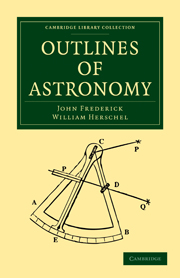CHAPTER XVIII
Published online by Cambridge University Press: 05 July 2011
Summary
(906). Time, like distance, may be measured by comparison with standards of any length, and all that is requisite for ascertaining correctly the length of any interval, is to be able to apply the standard to the interval throughout its whole extent, without overlapping on the one hand, or leaving unmeasured vacancies on the other; to determine, without the possible error of a unit, the number of integer standards which the interval admits of being interposed between its beginning and end; and to estimate precisely the fraction, over and above an integer, which remains when all the possible integers are subtracted.
(907). But though all standard units of time are equally possible, theoretically speaking, yet all are not, practically, equally convenient. The solar day is a natural interval which the wants and occupations of man in every state of society force upon him, and compel him to adopt as his fundamental unit of time. Its length as estimated from the departure of the sun from a given meridian, and its next return to the same, is subject, it is true, to an annual fluctuation in excess and defect of its mean value, amounting at its maximum to full half a minute. But except for astronomical purposes, this is too small a change to interfere in the slightest degree with its use, or to attract any attention, and the tacit substitution of its mean for its true (or variable) value may be considered as having been made from the earliest ages, by the ignorance of mankind that any such fluctuation existed.
- Type
- Chapter
- Information
- Outlines of Astronomy , pp. 622 - 644Publisher: Cambridge University PressPrint publication year: 2010First published in: 1864

